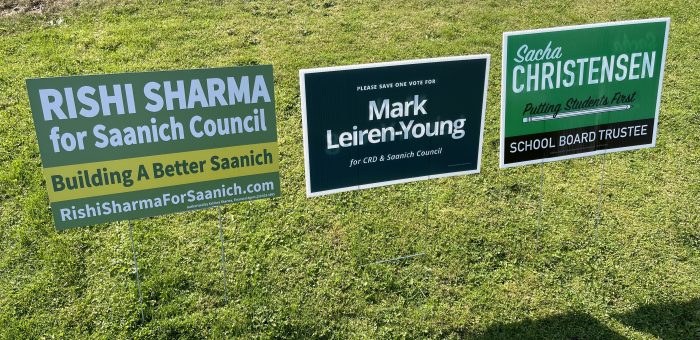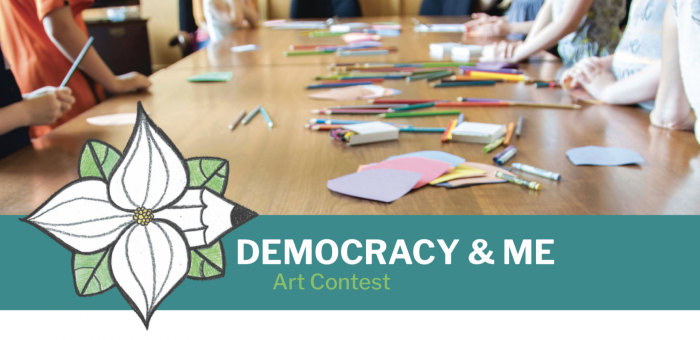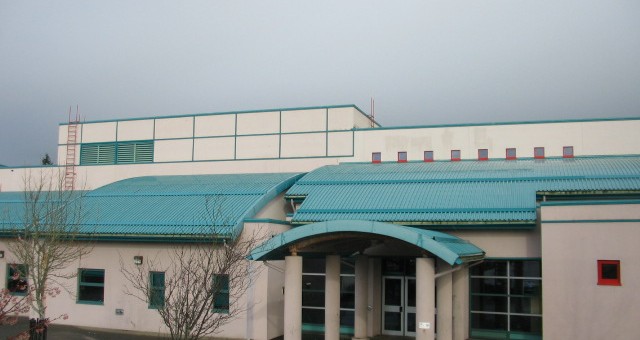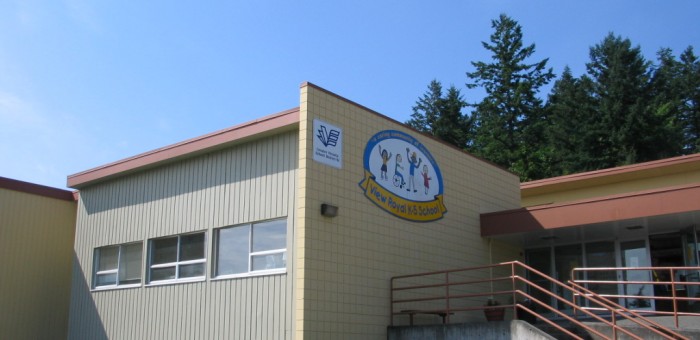K-12 Education
Thoughtful voices: Sacha Christensen, Mark Leiren-Young & Rishi Sharma
In 2012, as I started my journey to become the BC Green MLA for Oak Bay Gordon Head, I was only too aware of how difficult it would be to win against the incumbent, BC Liberal Ida Chong. I was running for a party that had never elected anyone at the provincial level anywhere in Canada. There were no “party lists” that we could draw from; there was no party “apparatus” to call upon; there was no real “election readiness” or “provincial strategy”. Each of the BC Green candidates had to organically grow their support from the bottom up. And we did so against difficult odds and without access to organization networks like those associated with the so-called BC NDP ground game. I believed that the pathway to victory involved vowing to do politics differently and promising to work with whomever formed government. Ultimately, this approach was successful and I was able to advance numerous bills working collaboratively with the BC Liberals (from 2013-2017) and then the BC NDP (from 2017-2020).
When we elect politicians to govern on our behalf, we are electing individuals who are each armed with a toolkit of life skills, experiences, qualifications and views. Ideally, each elected person has a complementary, rather than identical, set of tools in their tool kits. For when these complementary tools are spread out on the decision-making table, more creative, inclusive and thoughtful policy and solutions are built. But in my view, what is most important is that we elect individuals who recognize the importance of advancing lasting policy through good governance that transcends traditional partisan divides.
On October 15, we go to the polls in the next general local elections. While I have already voted in an advanced poll for a full and diverse slate of School Board and Council candidates, I wanted to highlight three remarkable individuals on my list. These individuals span the political spectrum, and exemplify what I look for in an elected leader. None of them are presently holding elected office and there are enough incumbents not running to ensure that new people must be at the Saanich Council and School District 61 Board tables. I provide my rationale as to why I voted for these three individuals to help others as they do their research on who they will support on October 15. I recognize the importance of name recognition in local government elections and perhaps by doing this, I might convince a few of you to reach out to the three candidates below to learn more about their compelling campaigns.
1) Sacha Christensen – candidate for SD61 Trustee.
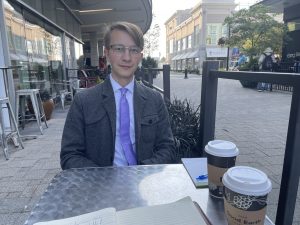 Despite the apparent lack of attention given to school board elections, Trustees in School District 61 actually manage a bigger budget ($268 million for 2022-23) than do the Mayor and Council of Saanich ($222 million for 2022-23). Over the past year, School District 61 was rocked with controversy as two trustees were suspended and subsequently reinstated. The annual budget process was also not without its own public controversy as music and support services took a hit to make ends meet. Given the turbulence of the past year, and with Board Chair Ryan Painter, Angie Hentze, and long time Trustees Elaine Leonard and Tom Ferris not seeking reelection, it is important to elect individuals with demonstrated expertise and experience who understand the importance of a collaborative, as opposed to an adversarial, approach to good governance.
Despite the apparent lack of attention given to school board elections, Trustees in School District 61 actually manage a bigger budget ($268 million for 2022-23) than do the Mayor and Council of Saanich ($222 million for 2022-23). Over the past year, School District 61 was rocked with controversy as two trustees were suspended and subsequently reinstated. The annual budget process was also not without its own public controversy as music and support services took a hit to make ends meet. Given the turbulence of the past year, and with Board Chair Ryan Painter, Angie Hentze, and long time Trustees Elaine Leonard and Tom Ferris not seeking reelection, it is important to elect individuals with demonstrated expertise and experience who understand the importance of a collaborative, as opposed to an adversarial, approach to good governance.
After being told by one of my children that I should consider voting for Sacha, I decided to interview him to learn more about why he was running to be a School Board Trustee at the age of 24. I was extremely impressed by his maturity, thoughtfulness and profound insight into civic and school politics.
Sacha graduated from the challenge program at Esquimalt High School and has completed his first two years of political science at Camosun College. For the past three years he has been working as the constituency assistant in Randall Garrison’s MP office. Constituency assistants play a critical non partisan role in an MP or MLA office. They are the front line staff who interact with and help constituents access the services available to them. As such, they are the public face of an MP or MLA in many community interactions. They should be unconditionally ethical and trustworthy, articulate, have exemplary interpersonal communication skills, hard working, intelligent and empathetic. It became quickly obvious to me why Randal Garrison had hired Sacha.
I asked Sacha why he chose to run to become a Trustee. He pointed out that the present make up of the Board was closer to retirement than to being back in school and that he felt it was critical to ensure students were always front and centre in School Board decision-making. He expressed concern over the 49% 5-year (57% 6-year) indigenous graduation rate in the district and the emergence of the VIVA slate of candidates who he did not believe shared his values. We talked about the lack of funding for students with diverse abilities and the troubling provincial model of education funding. I came away with the impression that Sacha was an exceptionally pragmatic thinker who understands how to advance policy solutions by bringing people together.
In summary, I am very impressed with Sacha Christensen’s collaborative approach to politics, as well as his perspective as a young candidate. I believe he has the expertise and experience to restore good governance to our school board.
More information on Sacha Christensen’s quest to become a Trustee in School District 62 is available on his campaign website.
2) Mark Leiren-Young — candidate for Saanich Council
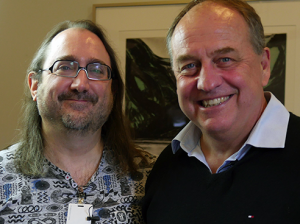 I first met Mark many years ago when he came to interview me at my office at the University of Victoria. Mark was doing a podcast series on trees and I had just completed my book: Generation Us – The Challenge of Global Warming. We hit it off right away.
I first met Mark many years ago when he came to interview me at my office at the University of Victoria. Mark was doing a podcast series on trees and I had just completed my book: Generation Us – The Challenge of Global Warming. We hit it off right away.
A few years later, I once more bumped into Mark on the set of Wes Borg’s live comedy show, Derwin Blanshard’s Extremely Classy Sunday Evening Program, a show that I had become a regular on before I got elected. He sang “Kumbaya” as I proceeded to “beat the character of an Irish ambassador to Canada“, who was cast as a rabid climate change denier on the show, with a large “Nobel prize” prop! It was good-natured humour and Mark and I saw each other in different lights! It was also the last show I did before getting elected! And then in 2017, Mark interviewed me again in the final days of the 2017 provincial election campaign just prior to our historic election result, wherein the BC Greens were afforded the balance of power in the 2017-2020 BC NDP minority government.
Mark has been surrounded by politics his entire life. His mother met his father when she was running for Vancouver City Council and he was covering it for The Vancouver Sun. His father went on to become the legislative reporter for The Sun and then Bill Bennett’s press secretary. Mark also covered politics as a journalist for years and – among other gigs – used to write for a magazine called Trade and Commerce where he helped translate municipal business plans into plain language to draw businesses and investors to municipalities throughout the lower mainland. He was approached about becoming the city hall columnist for a couple of Vancouver’s better media outlets. And he started writing for the Monday Magazine while he was still a UVic student.
Mark is an exceptionally gifted artist and communicator. He’s won numerous awards for his books, television, theatre and film productions and teaches in University of Victoria’s creative writing department. Virtually all of his work, including some of my his commercial work, has involved social or environmental themes. Mark is creative, collaborative, innovative, pragmatic and understands how to work across partisan divides to advance inclusive policy for our community.
More information on Mark Leiren-Young’s quest to become a Saanich Councillor is available on his campaign website.
3) Rishi Sharma — candidate for Saanich Council
 Rishi and I got to know each other in the 2013 provincial election campaign. He was the BC Liberal candidate for the riding of Saanich South and was running against my friend and colleague (from my days in the legislature), Lana Popham.
Rishi and I got to know each other in the 2013 provincial election campaign. He was the BC Liberal candidate for the riding of Saanich South and was running against my friend and colleague (from my days in the legislature), Lana Popham.
While I first met Rishi during an in-studio CFAX 1070 interview/debate early in the campaign, I got to know him better following an all candidates meeting that we we both participated in. Organized by the BC Sustainable Energy Association, this was a packed public event held at the Fernwood Community Centre on the theme: Energy and Climate. Rishi represented the BC Liberals. Rob Fleming (NDP), Duane Nickull (BC Conservatives) and I (BC Greens) were our party nominees. To no one’s surprise, the audience was not particularly warm towards the incumbent BC Liberal government. Yet it was clear to me why the BC Liberals sent Rishi to represent them. He was a compassionate listener and a thoughtful speaker.
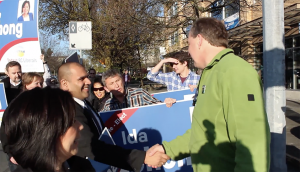 What also struck me early on about Rishi was the respect, ethics and integrity he brought to his election campaign. We were both representing different political parties, yet we were both able to converse in a collaborative way. We focused on our shared values and spoke about how we could advance creative solutions to the issues facing the province. And over the decade since we first met, I have followed Rishi’s work within the BC Government.
What also struck me early on about Rishi was the respect, ethics and integrity he brought to his election campaign. We were both representing different political parties, yet we were both able to converse in a collaborative way. We focused on our shared values and spoke about how we could advance creative solutions to the issues facing the province. And over the decade since we first met, I have followed Rishi’s work within the BC Government.
Unlike many candidates running for local government positions, Rishi was born in, grew up in, and still lives in the community of Saanich. He attended Hillcrest Elementary, Arbutus Junior High and Mount Doug High School. His postgraduate studies include classes at UVic, Camosun and, more recently, Royal Roads university where he is finishing off his MA in Organizational Leadership. Rishi was also an accomplished athlete, playing soccer for Gordon Head, Metro Victoria and the BC Selects, while also competing in field hockey. He continues to give back to the community as a volunteer coash with Saanich Fusion soccer.
One of the things that most impresses me about Rishi is his deep insight into the needs of our community. He is pragmatic, principled, empathetic and respectful in all his work. He also brings business acumen to the decision making table.
More information on Rishi Sharma’s quest to become a Saanich Councillor is available on his campaign website.
The Democracy & Me Art Contest is now open to all BC children & youth
The Legislative Assembly of British Columbia and the Lieutenant Governor of British Columbia have co-sponsored The Democracy & Me Art Contest.
 As noted in the contest poster to the right, it encourages K-12 students to create visual artwork that explores the importance of community and democracy.
As noted in the contest poster to the right, it encourages K-12 students to create visual artwork that explores the importance of community and democracy.
Contest winners will receive a trip to Victoria and their artwork will be displayed in the provincial Parliament Buildings.
Artwork must be submitted by January 31, 2020.
Please visit the The Democracy & Me Art Contest website for further details on how to submit your entry.
BC Green caucus celebrates equitable access to menstrual products for students
Great Victoria School District officially launched its initiative today to provide free access to menstrual products for students. Ensuring equitable access to menstrual products is an important issue long advocated for by groups like the United Way Period Promise campaign, and I am proud to have played a part in helping move this initiative along.
As you will see from my Question Period exchange the Minister of Social Development and Poverty Reduction:
“We all expect when we enter a public washroom that toilet paper is readily available and free. Why that isn’t the case for menstrual products is a very good question. One, I suspect, that if men had a menstrual cycle, we wouldn’t be asking today.“
Below I reproduce our media statement celebrating the BC Government and Victoria School District’s announcement.
Media Statement
BC Green caucus celebrates equitable access to menstrual products for students
For immediate release
September 5, 2019
VICTORIA, B.C. – Today the BC Green caucus is celebrating the official launch of the Greater Victoria School District’s initiative to provide free access to menstrual products for its students.
“Ensuring equitable access to menstrual products is an important issue long advocated for by groups like the United Way Period Promise campaign, and I am proud to have played a part in helping move this initiative along,” said B.C. Green Party Leader MLA Andrew Weaver.
In March, Weaver asked Minister of Social Development and Poverty Reduction, as well as the Minister of Education, how the upcoming poverty reduction strategy will ensure that all children and youth have equal access to menstrual products. One month later, government announced it would require all public schools in the province to provide free menstrual products in school washrooms.
“In a minority government, a key part of our role is to bring new ideas to the table, advocate for great ideas already out there, and work with government to inspire them to act. In this case, we are thrilled at the outcome,” Weaver said. “No student should feel restricted in their ability to participate in lessons or sports because they lack access to a basic need.
“Protecting children from harm -whether it be stigma or abuse- and advancing gender equity have been two areas in which the B.C. Green Caucus and B.C. NDP clearly agree. Making schools and society safer and more equitable for all of our children is a nonpartisan pursuit that unites British Columbians.”
A B.C. Green Caucus bill amending the Residential Tenancy Act garnered tripartisan support this May and passed with full votes from the NDP and Liberals. The bill provides renters who are victims of violence associated with their home, or whose children are victims of violence, to break their fixed term lease and seek safety.
Also in May, B.C. Greens, alongside stakeholders and LGBTQ2+ rights advocates, tabled legislation that would ban the abusive practice of conversion therapy.
“We hope government continues to show support for the children of British Columbia this fall by working with our caucus to ban so-called conversion therapy,” Weaver said.
-30-
Media contact
Macon L.C. McGinley | Press Secretary
B.C. Green Caucus
+1 250-882-6187 |macon.mcginley@leg.bc.ca
Governments have choices to make: subsidize LNG, remove bridge tolls or support public education
Children are starting the school year under a shadow of labour uncertainty. With the first day of the 2019-2020 academic year now behind us, teachers, children and their parents are wondering if and when contract negotiations will conclude or whether they will once more break down and lead to another strike.
Let’s be very clear, governments have choices to make. In the lead up to the 2017 election campaign, the BC Greens made public education our top priority. Our fully costed platform offered more than $4 billion in new funds over four years in support of this priority.
The BC NDP’s priorities are different. They have so far committed billions of dollars in subsidies to the oil and gas sector in an attempt to deliver what Christy Clark couldn’t — a single LNG facility. They have committed billions to build the Site C dam whose electricity will be sold at a massive loss to this single LNG provider. And they decided to forego billions of dollars of future revenue by removing the tolls on the Port Mann and Golden Ears bridges.
The BC Green 2017 platform promised to:
“Increase funding for schools, beginning in 2017/18 at $220 million and rising to $1.46 billion in 2020/21, to allow schools and school districts to invest in every child and prepare students for the 21st century economy, and to invest in innovation and technology. This is in addition to the $330 million committed by the BC Liberals to address the recent court ruling on class size.”
Public education is the foundation of any modern society. The BC Green party believes fundamentally in the importance of intergenerational equity and a preventative rather than reactive approaches to problem solving. For example, you will hear a lot about the struggles with the fentanyl crisis and young adults. Governments are good at funding “harm reduction projects” (reactive) but often don’t realize that prevention is just as critical. How many of our social problems today have arisen as a direct consequence of children growing up over the last dozen or so years without access to the services they needed to succeed (as these services were often the first casualties of the cuts to public education)?
The data from Statistics Canada are also very clear. BC Teachers are some of the lowest paid in the country. BC’s starting teacher wage is the second lowest in Canada (behind Quebec) and even after 10-15 years of experience, our BC teachers remain well behind most of the rest of Canada in terms of compensation. This wage gap is even more significant when one considers the cost of living in British Columbia, and in particular its urban areas, relative to the rest of the country. How can we expect to attract and retain the best and brightest to the profession if we are not willing to compensate them accordingly?
The BC Green public education platform extended beyond substantively increasing compensation for teachers and improving the support services for teachers and students. We further promised to:
- Provide $10 million per year to restore funding for adult secondary education upgrading and language training
- Direct $35 million into nutrition and physical activity programs to promote learning readiness, and improve student health.
- Invest $140 million over three years to train teachers to deliver the new curriculum.
- Work with Indigenous leaders, teachers, universities and colleges to develop policies and strategies to attract the brightest and best to the profession, and support recruitment. Special attention will be paid to increasing the number of Indigenous teachers and to incorporating more content on Indigenous culture into the curriculum.
- Review the funding model for the K-12 education system with a view to ensuring equitable access for students. This will address targeting funding to schools with the greatest need and increasing local autonomy regarding funding priorities and distribution.
Imagine my surprise when I found out last spring that government was putting forth some of essentially the same proposals in contract negotiations that the former government did in 2014. In particular, the BC government tabled language regarding larger maximum class sizes and fewer specialty teachers. On May 27, 2019 I rose in the legislature during Question Period to ask the Minister of Education what he was thinking in doing this. I further asked what the Minister thought this would do to the morale of B.C. teachers given that starting in 2002 and culminating in the landmark Supreme Court of Canada decision on November 10, 2016, the BCTF fought hard to restore provisions regarding their ability to bargain class size and composition. In fact, the teacher’s had historically given up wage increases in order to ensure class size and compensation language was included in collective agreements.
Unfortunately, while government has changed, labour uncertainty and unrest in the public education sector continues.
Back in 2014, I wrote extensively about the then labour dispute between the BCTF and the BC Liberal government. It began with a detailed piece offering a path forward for BC public education. A quick keyword search of this site with “BCTF” reveals numerous additional posts discussing mediation, arbitration, the government’s negotiating tactics and myriad other issues.
In my April 2015 second reading speech to Bill 11 – The Education Statutes Amendment Act, seven months after the end of the last teachers’ strike, I provided a more extensive analysis of my views on the importance of public education. Bill 11 aimed at unilaterally allowing government control over the professional development of teachers, and empowering government to issue directives to school boards that they would be bound to follow. In that speech I stated:
At the end of the strike last fall the government spoke about “an historic six-year agreement…which means five years of labour peace ahead of us.” Rather than viewing this as five years of simmering anger waiting to boil over when the negotiations next begin, we should be capitalizing on this time to envision bold new ways of ensuring our educational system is sustainable.
This includes teachers being fairly compensated and adequately supported with properly funded curriculum and learning resources. Such support must include sincere and meaningful class size and composition discussions and support that recognizes that teacher burnout affects us all. It must include reinvigorating our educational infrastructure and ensuring that children have textbooks and access to learning materials.
On Thursday the B.C. Court of Appeal will release its decision concerning the rights of teachers to negotiate conditions around class size and composition. Rather than allowing this to serve as a catalyst to incite increased tension between the BCTF and the government, perhaps both parties will recognize the opportunities that will arise from mutual collaboration, no matter what the Court of Appeals decision is.
For example, perhaps there is a compromise on class size and composition negotiations. Why don’t the BCTF and the B.C. government both agree, for example, that the best place to negotiate class size and composition is at the local school district level?
Rereading my “path forward” and “Bill 11” posts reminds me of how little has changed since the BC NDP have taken over from the BC Liberals. When it comes to public education, the BC Liberals and the BC NDP appear to be two sides of the same coin albeit with different colours.
To conclude, governments make choices all the time as to where to invest public resources. The BC Greens made public education ($4.022 billion over 4 years) our top priority and we remain committed in this regard.
As I mentioned at the start, the BC NDP’s priorities are different. They have so far committed billions of dollars in subsidies to the oil and gas sector in an attempt to deliver what Christy Clark couldn’t — a single LNG facility. They have committed billions to build the Site C dam whose electricity will be sold at a massive loss to this single LNG provider. And they decided to forego billions of dollars of future revenue by removing the tolls on the Port Mann and Golden Ears bridges.
Government’s make choices. And now you see what those choices are.
On the government’s approach to collective bargaining with the BCTF
In the legislature today I rose during Question Period to ask the Minister of Education what his government was thinking when they tabled their class size and composition proposals. I further asked what he thought this would do to the morale of B.C. teachers given that starting in 2002 and culminating in the landmark Supreme Court of Canada decision on November 10, 2016, the BCTF fought hard to restore provisions regarding their ability to bargain class size and composition.
In addition, I asked the minister how he reconciled his statement to the Globe and Mail on March 17th:
with the comments from BCTF president Glen Hansman to the Vancouver Sun on May 17:
Below I reproduce the video and text of our Question Period exchange.
The BC Green Party made public education our top priority in the last provincial election campaign. Our fully costed platform found more than $4 billion in new funds over four years in support of this priority.
Public education is the foundation of any modern society. The BC Green party believes fundamentally in the importance of intergenerational equity and a preventative rather than reactive approaches to problem solving. For example, you will hear a lot about the struggles with the fentanyl crisis and young adults. Governments are good at funding “harm reduction projects” (reactive) but often don’t realize that prevention is as critical. How many of our social problems today have arisen as a direct consequence of children growing up over the last dozen or so years without accesses to the services they needed to succeed (as they were often the first to get cut)? They still struggle.
Video of Exchange
Question
A. Weaver: Last week we heard from the BCTF that this government is putting forth essentially the same proposals in contract negotiations that the former government did in 2014. In particular, government has tabled larger maximum class sizes and fewer specialty teachers.
In 2014, the now Minister of Education stated that class size and composition was a “central issue” in the ongoing teachers strike at the time and that it was “critical” and that “class size and composition do impact learning outcomes.”
My question is to the Minister of Education. Starting in 2002 and culminating in the landmark Supreme Court of Canada decision on November 10, 2016, the BCTF fought hard to restore provisions regarding their ability to bargain class size and composition. What was government thinking when they tabled their class size and composition proposals, and what does he think this will do to the morale of B.C. teachers?
Answer
Hon. R. Fleming: I thank the member for the question, because he did indeed go through a litany of damaging years in public education in British Columbia that stand in stark contrast to the record of our government over the last 21 months. Let’s remember that for 16 years, that government over there, the opposition now, fought with teachers, ripped up contracts….
Interjections.
Mr. Speaker: Members. Members, the Minister of Education has the floor.
Interjections.
Hon. R. Fleming: I think they’re a little sensitive, Mr. Speaker, about losing in court…
Interjections.
Mr. Speaker: Members.
Hon. R. Fleming: …three times. Three times, Mr. Speaker.
Interjections.
Mr. Speaker: Members.
Minister of Education.
Hon. R. Fleming: Thank you, Mr. Speaker. It’s really sensitive, because they lost three times in the Supreme Court.
The point is, they wasted 12 years, they ripped resources away from kids and families, they demonized teachers, and they lost. We’re taking a different approach.
Interjections.
Hon. R. Fleming: I think the member who asked the question would like an answer. I think he would appreciate it, and here’s what the answer is. In 21 months, our government has added $1 billion of annual resource….
Interjections.
Hon. R. Fleming: We’ve hired 4,000 new teachers and 1,000 education assistants. Funding for students with special needs is up 23 percent. Rural education funding is at a record high and up under our government.
Mr. Speaker: Members.
Hon. R. Fleming: I would ask the members opposite to read some headlines they might not want to read. The Delta Optimist, the Kelowna Courier — each one of them is saying that for the first time in 15 years, they don’t have to cut budgets. They don’t have to fire teachers. They’ve got funding and a government that’s on their side.
Supplementary Question
A. Weaver: I thank the minister for the answer to the question. I’m not sure it was the question that I asked, but at least there was a long answer there, so I do appreciate the words and the facts being brought forward.
In 2014, the current Minister of Education spoke passionately about how the B.C. budget of the day: “It robs from the pocketbooks of ordinary British Columbians and fails to invest in the future.” He was talking about the lack of education support, specifically the lack of school support workers at the time.
According to the BCTF president, Glen Hansman, this new position of the B.C. government would: “Wipe out each and every word that teachers got back through the Supreme Court of Canada decision and replace it with watered-down language that’s worse than what exists in most school districts across the province.”
On March 17, the Minister of Education told the Globe and Mail this: “The table is set different than any set of negotiations in the last 16 years. Our government is not seeking any concessions. We are seeking changes that will benefit teachers and students.”
My question is to the Minister of Education. How does he reconcile this quote with the claims of the BCTF president?
Answer
Hon. R. Fleming: I thank the member for the question again. He’ll know this as somebody who was a former negotiator himself for labour: that bargaining is best done at the table. What I’m proud of is our government…. We have gone to the table in this round of negotiations earlier than ever before. We have set the table with record levels of funding. I can go through that list again for the members present, but they’ve all been at school announcements in their ridings, so they know about it firsthand.
We have also demonstrated respect to the teaching profession. We have now, I’m pleased to say, 197,000 public servants in British Columbia who have signed on with tentative agreements under the sustainable services mandating agreement. We have 25,000 CUPE K-to-12 education workers who are included in that group.
I would say to the member to also listen to Mr. Hansman. He said, going into the weekend, and I would echo this message with him: “We’re still optimistic that there will be a deal. We have five weeks until the end of the school year. The good news is that both sides have scheduled a lot of dates, so there’s a lot of room to talk. That’s positive. We didn’t have that in the last few rounds.” So I will respectfully allow elected trustees — who we restored, democratically, to the bargaining process — to do their work. They understand teachers. They work alongside teachers. The previous government fired them, and I think that was a huge mistake. That is the stark contrast that we have here.
If members want to think back exactly five years ago, they locked out teachers. They cut their pay. They provoked British Columbia’s education system, and it was a disaster. It led to the longest shutdown of schools in British Columbia history. We’re in a vastly different place, where we want to work with teachers and school districts and get a good deal that’s good for everyone.

